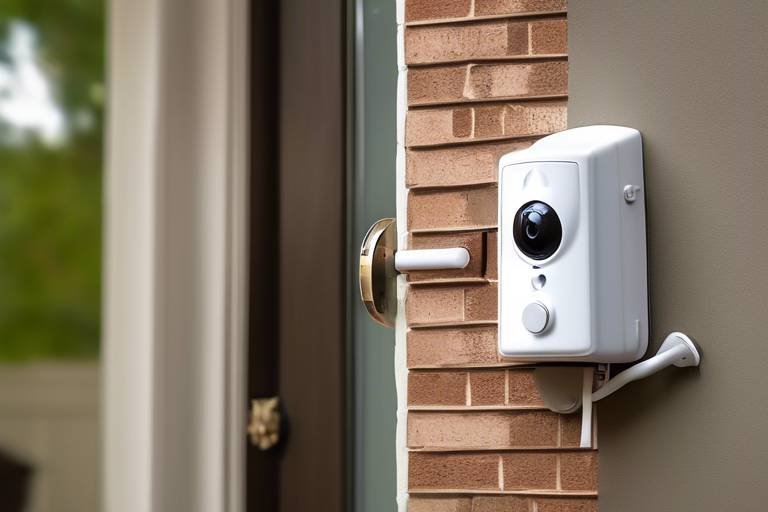The Physics of Home Security Systems - How They Protect Us
In today's world, where safety is a top priority, home security systems have become essential for protecting our loved ones and belongings. But have you ever wondered how these systems actually work? The answer lies in the fascinating realm of physics. From the way sensors detect movement to how alarms communicate threats, understanding the physics behind these technologies can give us a greater appreciation for their capabilities. In this article, we'll dive into the intricate details of how various components of home security systems function, exploring the principles of physics that keep us safe and secure.
At the heart of any effective home security system are security sensors. These devices are designed to monitor specific areas and alert homeowners of any unauthorized access. Motion detectors, for instance, utilize the principles of infrared radiation. They work by detecting changes in heat emitted by objects within their range. When a person or animal moves into the sensor's field, the change in temperature triggers an alert. Similarly, door and window sensors rely on magnetic fields. When a door or window opens, the magnetic connection is broken, signaling a potential breach. This seamless integration of physics and technology is what makes security sensors so effective.
Alarms are another critical component of home security systems. Their primary function is to deter intruders and alert homeowners of a potential threat. But how do they achieve this? The answer is rooted in the physics of sound waves and signal transmission. When a sensor is triggered, it sends a signal to the alarm system, which then emits a loud noise designed to scare off intruders and alert anyone nearby. The intensity of the sound and the frequency at which it operates are carefully calibrated to ensure maximum effectiveness. Think of it like a firework: the louder and more vibrant the explosion, the more attention it draws, and the same principle applies to alarm systems.
When it comes to alarm systems, there are two main types: wired and wireless. Each has its unique advantages and operates based on different principles of physics. Understanding these differences can help homeowners choose the best system for their needs.
Wired alarm systems rely on physical connections through electrical wiring. These systems are known for their reliability and consistent performance. The physics behind them involves electrical circuits that allow signals to travel from sensors to the control panel. This direct connection minimizes the risk of interference and ensures that alarms are triggered promptly. However, installation can be more complex, often requiring professional assistance to set up the wiring throughout the home.
On the other hand, wireless alarm systems use radio frequencies to communicate between devices. This technology allows for greater flexibility in installation, as there are no wires to run through walls. The physics involved here is fascinating; radio waves can travel through various materials, allowing sensors to communicate with the alarm system from a distance. While these systems are generally easier to install, they can be susceptible to interference from other wireless devices. Nonetheless, their convenience and adaptability make them a popular choice among homeowners.
Surveillance cameras play a vital role in home security by providing a visual record of activities around your property. But how do they capture such clear footage? The answer lies in the physics of optics. Cameras use lenses to focus light onto a sensor, which then converts the light into an electronic signal. This process involves intricate calculations of angles and light refraction, ensuring that images are sharp and detailed. Additionally, advancements in imaging technology, such as infrared night vision, allow cameras to capture clear images even in low-light conditions, enhancing overall security.
With the rise of smart home technology, home security systems have become more interconnected than ever. This integration allows for automation and remote control of security features. But how does this all work? At the core of smart home systems is the principle of data communication. Devices communicate over the internet, sharing information and responding to commands in real-time. This interconnectedness creates a cohesive security network that can be monitored and controlled from anywhere, providing peace of mind for homeowners.
The Internet of Things (IoT) has revolutionized home security by enabling devices to interact and share data seamlessly. For example, when a motion sensor detects movement, it can trigger a camera to start recording and send an alert to the homeowner's smartphone. This real-time interaction is made possible through the physics of data transmission, where information is sent quickly and efficiently over the internet. The result is a more responsive and effective security system that adapts to the needs of the homeowner.
One of the most appealing aspects of modern security systems is the ability to monitor your home from anywhere in the world. Thanks to advancements in technology, homeowners can access live feeds from surveillance cameras and receive alerts on their smartphones. The physics behind this capability involves data transmission over the internet, allowing for real-time updates. This means you can keep an eye on your property while on vacation or at work, providing an added layer of security and peace of mind.
- How do motion detectors work? Motion detectors use infrared technology to detect changes in heat, alerting the system when movement is detected.
- What are the benefits of wireless alarm systems? Wireless systems are easier to install and offer flexibility in placement, making them a popular choice for many homeowners.
- Can I monitor my security system remotely? Yes, many modern security systems allow for remote monitoring through smartphone apps.

Understanding Security Sensors
When it comes to home security, security sensors are the unsung heroes that keep our homes safe from unwanted intruders. They work silently in the background, yet their impact is profound. But how do these sensors actually function? At their core, security sensors rely on fundamental principles of physics to detect movement or unauthorized access. Understanding these principles can give us a deeper appreciation for how they protect our homes.
One of the most common types of security sensors is the motion detector. These devices typically use either passive infrared (PIR) technology or microwave technology to sense movement. PIR sensors detect changes in infrared radiation, which is emitted by warm bodies, like humans or animals. When someone walks into the sensor's field of view, the change in infrared levels triggers an alert. Imagine it like a heat-seeking missile, but instead of targeting a moving object, it simply signals an alarm when it notices a change in temperature.
On the other hand, door and window sensors operate using a different principle. These sensors usually consist of two parts: a magnet and a sensor switch. When a door or window is closed, the magnet keeps the sensor switch in a closed position. However, when the door or window opens, the magnet moves away from the sensor, causing it to activate the alarm. It’s like a secret handshake between two friends; as long as they’re close, everything is fine, but the moment they part ways, the alarm goes off!
In addition to motion detectors and door/window sensors, there are also glass break sensors. These sensors listen for the specific frequency of glass breaking. When they detect that sound, they immediately trigger an alarm. It’s fascinating how these devices can differentiate between the sound of a window breaking and other noises, much like how we can distinguish between a friend’s voice and background chatter at a party.
To give you a clearer picture, here's a simple table summarizing the different types of security sensors and their functionalities:
| Type of Sensor | Functionality |
|---|---|
| Motion Detectors | Detects movement using infrared or microwave technology. |
| Door/Window Sensors | Uses a magnet and sensor switch to detect openings. |
| Glass Break Sensors | Detects the sound frequency of breaking glass. |
As technology advances, we also see the emergence of smart sensors that integrate with home automation systems. These sensors can be controlled remotely and can send alerts directly to your smartphone. Imagine being on vacation and receiving a notification that a window sensor has been triggered; you could check your security cameras in real-time, giving you peace of mind even when you’re miles away. This level of connectivity is made possible through the principles of data transmission and networking, showcasing how physics continues to play a vital role in our everyday lives.
In conclusion, understanding how security sensors operate gives us insights into the physics that underpins our home security systems. They are not just gadgets; they are sophisticated devices that utilize the laws of nature to keep our homes safe. Whether it’s through detecting movement, monitoring openings, or listening for specific sounds, these sensors work tirelessly to provide us with the protection we need. So, the next time you hear that reassuring beep when you arm your security system, remember the science working behind the scenes to keep you and your loved ones safe.

The Role of Alarms
Alarms are more than just loud noises; they serve as a critical deterrent and an alert mechanism designed to protect our homes and loved ones. Imagine this: you're cozy on the couch, binge-watching your favorite series, when suddenly, a piercing alarm shatters the silence. It’s not just a nuisance; it’s a lifeline that signals danger and prompts immediate action. But how do these systems work, and what physics principles lie behind their effectiveness?
At the heart of alarm systems is the science of sound waves. When a security breach occurs, the alarm triggers a loud sound that travels through the air in waves, reaching anyone nearby. This sound serves two vital purposes: it alerts the homeowner and can scare off potential intruders. The intensity of the sound, measured in decibels, plays a crucial role in its effectiveness. For instance, a 120-decibel alarm can be heard from several blocks away, making it highly effective in deterring crime.
Additionally, alarm systems utilize signal transmission to communicate with monitoring stations or mobile devices. When an alarm is triggered, it sends a signal, often through a wired or wireless network, to notify the homeowner or a professional monitoring service. This transmission relies on the principles of electromagnetism and radio waves, ensuring that alerts are sent quickly and efficiently. The speed at which these signals travel is crucial; in emergency situations, every second counts.
Different alarm systems vary in their design and functionality. Some may use a simple siren that activates upon a breach, while others incorporate more sophisticated features such as:
- Motion Sensors: Detect movement within a designated area.
- Glass Break Sensors: Identify the sound frequency of breaking glass.
- Smoke Detectors: Alert homeowners to fire hazards, adding another layer of safety.
Each type of alarm system has its own unique physics at play. For example, motion sensors often use infrared technology to detect body heat, while glass break sensors analyze sound frequencies. Understanding these technologies can help homeowners choose the best system for their needs.
In summary, alarms are an essential component of home security systems, relying on the principles of sound and signal transmission to protect our homes. They not only alert us to potential threats but also act as a psychological barrier against intruders. With advancements in technology, alarm systems continue to evolve, offering more features and improved reliability. So, next time you hear that alarm go off, remember the complex physics working behind the scenes to keep you safe!

Types of Alarm Systems
When it comes to securing our homes, understanding the available can make a world of difference. Each system comes with its own unique features, advantages, and operational principles that reflect the underlying physics at play. Broadly speaking, alarm systems can be categorized into two main types: wired and wireless. Each type has its own set of characteristics that cater to different needs, preferences, and situations.
Wired alarm systems are the traditional choice for many homeowners. These systems rely on a network of electrical wires to connect various components, such as sensors, alarms, and control panels. The beauty of wired systems lies in their reliability; once installed, they are less susceptible to interference from external factors like radio waves or signal obstructions. However, the installation process can be quite invasive, often requiring drilling and running wires through walls, which may not be ideal for everyone. The physics behind these systems is rooted in electrical circuits, where the flow of electricity triggers alarms and sensors, creating a robust defense against intruders.
On the flip side, we have wireless alarm systems, which have gained popularity in recent years due to their flexibility and ease of installation. These systems utilize radio frequencies to communicate between devices, eliminating the need for extensive wiring. This means that homeowners can easily install and reposition sensors and cameras without the hassle of wires. The physics involved here is particularly fascinating, as it involves the transmission of electromagnetic waves that carry signals over varying distances. Wireless systems can be particularly advantageous for renters or those looking to avoid extensive renovations. However, they do rely on battery power, which necessitates regular maintenance to ensure that everything is functioning properly.
To summarize the distinctions between wired and wireless alarm systems, consider the following table:
| Feature | Wired Alarm Systems | Wireless Alarm Systems |
|---|---|---|
| Installation | Invasive, requires wiring | Easy, minimal installation effort |
| Reliability | Highly reliable | Can be affected by interference |
| Maintenance | Low, generally stable | Requires battery changes |
| Cost | Higher initial cost due to installation | Generally lower initial cost |
Choosing between wired and wireless alarm systems ultimately comes down to personal preference, budget, and the specific needs of your home. While wired systems boast reliability and stability, wireless systems offer flexibility and ease of use. In any case, both types of systems are designed to work harmoniously within the broader context of home security, ensuring that your sanctuary remains safe from unwanted intrusions.
So, which type of alarm system is right for you? It's essential to weigh the pros and cons of each option carefully. After all, your home deserves the best protection possible!
- What is the main advantage of a wired alarm system? Wired systems are known for their reliability and lower vulnerability to interference.
- Are wireless alarm systems easy to install? Yes, they typically require minimal installation effort and can be set up quickly.
- How often do I need to replace batteries in wireless systems? It depends on usage, but it's generally recommended to check them every 6 to 12 months.
- Can I integrate both wired and wireless systems? Absolutely! Many homeowners choose a hybrid approach for added flexibility and security.

Wired Alarm Systems
Wired alarm systems are the backbone of many traditional home security setups, relying on a network of electrical connections to function seamlessly. These systems operate on the fundamental principles of electrical circuits, where each component is interconnected, allowing for real-time communication and alerts. When a sensor is triggered—be it a motion detector or a door/window sensor—the circuit completes, sending a signal to the control panel. This immediate response is crucial in deterring potential intruders, as it ensures that any unauthorized access is detected and reported without delay.
One of the primary advantages of wired alarm systems is their reliability. Unlike their wireless counterparts, which can be susceptible to interference or signal loss, wired systems offer a direct connection that is less prone to disruptions. This makes them particularly effective in environments where a stable connection is paramount. Furthermore, since the system is hardwired, it does not rely on batteries that may need frequent replacement, reducing maintenance concerns for homeowners.
Moreover, the installation of wired systems can be a bit more complex, often requiring professional assistance to ensure that all wires are properly routed and concealed. However, this complexity can also be viewed as a benefit, as it often results in a more secure setup. With wires hidden within walls, it becomes significantly more challenging for intruders to tamper with the system. In essence, a well-installed wired alarm system can provide peace of mind, knowing that your home is safeguarded by a robust and reliable network of sensors and alarms.
To illustrate the operational efficiency of wired alarm systems, consider the following table that compares the key features of wired and wireless systems:
| Feature | Wired Alarm Systems | Wireless Alarm Systems |
|---|---|---|
| Reliability | High - Less prone to interference | Moderate - Susceptible to signal loss |
| Installation | Complex - Requires professional installation | Simple - DIY installation possible |
| Maintenance | Low - No batteries to replace | Moderate - Batteries may need regular replacement |
| Security | High - Difficult to tamper with | Moderate - Can be vulnerable to hacking |
In conclusion, while wired alarm systems may require a more involved installation process, their reliability and security features make them an excellent choice for homeowners looking to enhance their safety. They embody the essence of traditional security methods, proving that sometimes, the old ways are still the best.
- What are the main advantages of wired alarm systems? Wired systems are highly reliable, less prone to interference, and often more secure than wireless systems.
- Do wired alarm systems require professional installation? Yes, due to the complexity of installation, it is recommended to hire professionals for wired alarm systems.
- How do wired systems communicate with the control panel? They use electrical circuits to send signals when a sensor is triggered.
- Are there any maintenance concerns with wired systems? Maintenance is generally low as there are no batteries to replace, but regular checks on the system are advisable.

Wireless Alarm Systems
Wireless alarm systems have revolutionized the way we think about home security. Unlike their wired counterparts, these systems operate without the need for extensive electrical wiring, making them incredibly flexible and easy to install. Imagine being able to set up a security system in your home without the hassle of drilling holes and running cables through walls—this is the beauty of wireless technology. At the heart of these systems lies the use of radio frequencies to communicate between devices, allowing for seamless integration and operation.
One of the most significant advantages of wireless alarm systems is their portability. Homeowners can easily relocate sensors and cameras as needed, adapting their security setup to changing circumstances. For instance, if you decide to rearrange your living room or move to a new house, a wireless system can be reconfigured in a matter of minutes. This flexibility is particularly beneficial for renters or those who frequently change their living situations.
The physics behind these systems is fascinating. Wireless alarm systems typically use transmitters and receivers that operate on specific frequencies. When a sensor detects motion or a door/window is opened, it sends a signal to the control panel, which then triggers the alarm. This process involves electromagnetic waves that travel through the air, allowing for communication without physical connections. The efficiency of these waves is influenced by factors such as distance, obstacles, and interference from other electronic devices.
To give you a clearer picture, consider the following table that outlines some of the key features of wireless alarm systems compared to wired systems:
| Feature | Wireless Alarm Systems | Wired Alarm Systems |
|---|---|---|
| Installation | Quick and easy, no drilling required | Time-consuming, requires professional installation |
| Flexibility | Highly portable, easy to relocate | Fixed installation, difficult to move |
| Maintenance | Battery replacement needed | Less frequent maintenance, but wiring can fail |
| Signal Range | Limited by distance and obstacles | Not affected by distance, but wiring can be cumbersome |
While wireless alarm systems are incredibly convenient, they are not without their challenges. The reliance on batteries means that homeowners must stay vigilant about replacing them regularly to ensure the system remains operational. Additionally, wireless signals can sometimes be disrupted by physical barriers or interference from other devices, which is why it’s essential to choose a system with a robust signal range and advanced technology to minimize these issues.
In conclusion, wireless alarm systems exemplify how innovation in physics can lead to enhanced home security. They provide a practical solution for those looking to protect their homes without the headaches of traditional wiring. If you’re considering upgrading your home security, a wireless system might just be the perfect fit for your needs.
- How do wireless alarm systems work?
Wireless alarm systems use radio frequencies to communicate between sensors and the control panel. When a sensor is triggered, it sends a signal to the control panel, which activates the alarm. - Are wireless alarm systems reliable?
Yes, wireless alarm systems are generally reliable, but it's important to choose a high-quality system to minimize issues with signal interference or battery failure. - Can I install a wireless alarm system myself?
Absolutely! One of the main benefits of wireless systems is their ease of installation. Most systems come with clear instructions, allowing you to set them up without professional help. - How often do I need to replace the batteries in a wireless system?
Battery life can vary based on the system and usage, but it's advisable to check and replace batteries every 6 to 12 months to ensure optimal performance.

Surveillance Cameras and Imaging Technology
When it comes to home security, surveillance cameras play a pivotal role in monitoring and recording activities around your property. But have you ever wondered how these devices capture such clear images? The answer lies in the fascinating world of optics and imaging technology. At their core, surveillance cameras utilize a combination of lenses and sensors to convert light into electrical signals, which are then processed to produce the images we see. This process is not just a stroke of luck; it’s a well-orchestrated dance of physics that ensures we can keep an eye on our homes even when we’re miles away.
The basic components of a surveillance camera include the lens, image sensor, and video processor. The lens gathers light from the environment and focuses it onto the image sensor. This sensor, often a Charge-Coupled Device (CCD) or a Complementary Metal-Oxide-Semiconductor (CMOS), converts the light into an electrical signal. The video processor then takes this signal and transforms it into a digital image. The clarity and detail of the captured footage depend heavily on the quality of these components and their ability to work together seamlessly.
Moreover, the physics of light plays a crucial role in how effectively a camera can capture images in different lighting conditions. For instance, cameras equipped with infrared technology can see in the dark by using infrared light, which is invisible to the human eye. This technology is particularly beneficial for nighttime surveillance, allowing homeowners to monitor their properties even when the sun goes down. The ability to capture images in low light is achieved through a phenomenon known as photonic sensitivity, where the camera sensors are designed to detect and amplify the minimal light available.
Another fascinating aspect of surveillance cameras is their ability to transmit video footage in real-time. This is where the physics of data transmission comes into play. Most modern surveillance systems use IP cameras that connect to the internet, allowing for the streaming of video feeds to your smartphone or computer. This is made possible by the principles of electromagnetic waves, which enable the transfer of data over long distances without the need for physical cables. It’s like sending a postcard across the globe, but instead of ink on paper, you’re sending high-definition video!
To give you a clearer picture of how these components work together, here’s a simple table summarizing the key elements of surveillance cameras:
| Component | Function |
|---|---|
| Lens | Focuses light onto the image sensor |
| Image Sensor | Converts light into electrical signals |
| Video Processor | Transforms electrical signals into digital images |
| Infrared Technology | Allows for night vision capabilities |
| Data Transmission | Sends video feeds to remote devices |
In conclusion, surveillance cameras are not just passive observers; they are sophisticated devices that rely on the principles of physics to enhance our home security. From capturing crystal-clear images to transmitting video feeds in real-time, these technologies work tirelessly to keep us safe. So next time you glance at a security camera, remember the intricate science behind it, and how it contributes to the peace of mind we all seek in our homes.
- What types of surveillance cameras are available? There are various types, including dome cameras, bullet cameras, and PTZ (pan-tilt-zoom) cameras, each designed for different monitoring needs.
- How do I choose the right camera for my home? Consider factors like resolution, field of view, night vision capabilities, and whether you want wired or wireless options.
- Can I view my surveillance footage remotely? Yes, most modern surveillance systems allow you to access live feeds and recorded footage through smartphone apps or web browsers.

Smart Home Integration
In today's fast-paced world, has become a buzzword that’s reshaping how we think about home security. Imagine being able to control your security system with just a few taps on your smartphone or even through voice commands! This seamless interaction between devices is made possible by the principles of physics and advanced technology. But how exactly does it all work together to keep our homes safe?
At the heart of smart home integration is the Internet of Things (IoT), a network of interconnected devices that communicate with each other. These devices range from security cameras and motion detectors to smart locks and lighting systems. They work together in harmony, much like a well-coordinated orchestra, where each instrument plays its part to create a beautiful symphony of security. By using physics principles such as signal transmission and data processing, these devices can send and receive information in real-time, allowing homeowners to monitor their properties from anywhere.
One of the most significant advantages of smart home integration is the automation it offers. For instance, when you leave your home, your smart security system can automatically lock the doors, turn off the lights, and even activate the surveillance cameras—all without you lifting a finger. This not only enhances security but also provides peace of mind. It's like having a personal security guard that never sleeps!
Moreover, the communication protocols used in smart home devices, such as Wi-Fi, Zigbee, and Z-Wave, are based on the principles of physics that govern electromagnetic waves. These protocols allow devices to connect and communicate efficiently, ensuring that your security system is always up to date. For example, if a motion sensor detects movement, it can instantly send a signal to your smartphone, alerting you to potential intruders. This instantaneous feedback loop is crucial in enhancing home safety.
To illustrate the impact of smart home integration, consider the following table that summarizes the key benefits:
| Benefit | Description |
|---|---|
| Real-time Monitoring | Access live video feeds and alerts from your devices anytime, anywhere. |
| Remote Control | Control your security system through a smartphone app or voice commands. |
| Automation | Set up routines that automatically activate or deactivate security features. |
| Integration | Connect with other smart home devices for a cohesive security network. |
As we delve deeper into the world of smart home technology, we realize that the integration of various devices not only enhances security but also contributes to energy efficiency. For example, smart lighting systems can be programmed to turn off when the home is empty, reducing energy consumption and costs. It's a win-win situation!
In conclusion, smart home integration is revolutionizing how we approach home security. By leveraging the principles of physics and cutting-edge technology, we can create a secure and efficient living environment that adapts to our needs. Whether you're at home or on the go, the peace of mind that comes from knowing your home is well-protected is invaluable.
- What is smart home integration? Smart home integration refers to the interconnectedness of various smart devices that work together to enhance home security and convenience.
- How do smart home devices communicate? They communicate through various communication protocols like Wi-Fi, Zigbee, and Z-Wave, which are based on the principles of physics governing electromagnetic waves.
- Can I control my security system remotely? Yes! Most smart home security systems allow you to monitor and control them via a smartphone app from anywhere.
- What are the benefits of automation in smart home security? Automation provides convenience, enhances security, and can help reduce energy consumption by managing devices based on your routines.

IoT and Home Security
The Internet of Things, or IoT, has revolutionized the way we think about home security. Imagine a world where your home can communicate with you, alerting you to potential threats even when you're miles away! This is not just a dream; it's a reality made possible through the ingenious application of physics and technology. IoT devices, such as smart locks, cameras, and motion sensors, can be interconnected, creating a seamless security network that enhances safety and peace of mind.
At the core of this technology is the ability of devices to send and receive data wirelessly. Using radio frequencies, these devices can communicate with each other and with your smartphone or computer. For instance, when a motion sensor detects movement, it sends a signal to your smartphone, alerting you instantly. This is where physics comes into play—understanding how signals transmit through air and how devices can interpret these signals is fundamental to making IoT security systems effective.
Moreover, the integration of IoT in home security systems allows for real-time monitoring. Homeowners can access live feeds from surveillance cameras, control locks, and receive alerts about unusual activities—all from their mobile devices. This level of control not only enhances security but also provides a sense of empowerment. You can be on vacation halfway across the globe and still keep an eye on your home, thanks to the physics of wireless communication and data processing.
One of the most exciting aspects of IoT in home security is its scalability. Homeowners can start with a few devices and expand their systems as needed. For example, you might begin with a smart doorbell camera and later add window sensors or smart lighting. This flexibility is crucial because it allows homeowners to tailor their security systems to their specific needs without the hassle of complex installations.
However, with great power comes great responsibility. While IoT devices enhance security, they also introduce potential vulnerabilities. Cybersecurity is a major concern, as these devices can be targets for hackers. It’s essential to implement strong passwords, regular updates, and secure networks to safeguard your smart home. Understanding the physics behind encryption and data protection can help homeowners take proactive measures to protect their devices.
In conclusion, the integration of IoT in home security systems is a game-changer. It combines the principles of physics with cutting-edge technology, creating a robust security framework that is both efficient and user-friendly. By embracing IoT, homeowners can enjoy enhanced safety, convenience, and the ability to monitor their properties from virtually anywhere in the world.
- What is IoT in home security?
IoT in home security refers to interconnected devices that communicate with each other to enhance the safety and monitoring of a home. - How does IoT improve home security?
IoT improves home security by allowing real-time monitoring, remote access, and automated alerts for potential threats. - Are IoT devices secure?
While IoT devices can enhance security, they can also be vulnerable to hacking. It's important to implement strong security measures. - Can I integrate IoT devices with my existing security system?
Yes, many IoT devices are designed to be compatible with existing security systems, allowing for easy integration.

Remote Monitoring
In today's fast-paced world, the concept of has revolutionized how we keep an eye on our homes. Imagine being able to check on your property while sipping coffee at a café across town or even while vacationing on a tropical beach. This capability is not just a luxury; it's becoming a necessity for homeowners looking to enhance their security. Remote monitoring systems utilize advanced technology to transmit data in real-time, allowing homeowners to stay connected to their security systems from virtually anywhere.
The physics behind remote monitoring primarily revolves around data transmission and signal processing. When a security camera captures footage, that data needs to travel to your device, be it a smartphone, tablet, or computer. This is where the principles of physics come into play. For instance, cameras convert light into electrical signals, which are then compressed and transmitted over the internet using various protocols. This process involves a series of complex calculations and signal manipulations that ensure you receive a clear and accurate representation of your property.
One of the most exciting aspects of remote monitoring is the ability to access live feeds. This feature is made possible through the use of IP cameras, which connect to a network and transmit video data in real-time. The technology leverages internet connectivity to provide seamless access to video streams. This means that even if you’re miles away, you can quickly check in on your home with just a few taps on your smartphone. Additionally, many systems allow for two-way audio communication, enabling you to interact with anyone on your property, whether it's a delivery person or an unexpected visitor.
Moreover, remote monitoring systems often come equipped with motion detection capabilities. This feature uses sensors that rely on principles of physics to detect movement within a specified range. When motion is detected, an alert is sent to your device, allowing you to take immediate action if necessary. This not only enhances your security but also provides peace of mind knowing that you are always in the loop.
To illustrate the technology behind remote monitoring, consider the following table that summarizes the key components:
| Component | Function |
|---|---|
| IP Cameras | Capture and transmit video data over the internet. |
| Motion Sensors | Detect movement and trigger alerts. |
| Mobile App | Allows users to access live feeds and control security settings remotely. |
| Cloud Storage | Stores video footage for later review and analysis. |
In conclusion, remote monitoring systems are a game-changer in home security. They not only provide a sense of safety but also empower homeowners with the ability to manage their security systems from anywhere. As technology continues to evolve, we can expect even more innovative features that will enhance our ability to protect our homes. So, the next time you're out and about, remember that with remote monitoring, your home is just a tap away!
- What is remote monitoring?
Remote monitoring refers to the ability to oversee and manage your home security system from a distance, typically through a smartphone or computer.
- How does remote monitoring work?
It works by using internet-connected devices, such as IP cameras and motion sensors, to capture data and transmit it to your personal device in real-time.
- Can I access my security cameras remotely?
Yes, most modern security systems allow you to view live camera feeds through a dedicated mobile app or web interface.
- What happens if my internet goes down?
Some systems may have backup options like local storage, but remote access will be unavailable until the internet is restored.
Frequently Asked Questions
- What are security sensors and how do they work?
Security sensors are essential components of home security systems designed to detect unauthorized entry. They operate using principles of physics, such as motion detection through infrared technology or magnetic fields for door/window sensors. When someone crosses the sensor's path or opens a door, the system is triggered, alerting homeowners to potential intrusions.
- How do alarm systems deter intruders?
Alarm systems work by emitting loud sounds that can startle intruders and alert homeowners or neighbors. The physics of sound waves plays a crucial role here; the louder the alarm, the more likely it is to deter an intruder. Additionally, the mere presence of an alarm can serve as a psychological barrier, making potential burglars think twice before attempting to break in.
- What is the difference between wired and wireless alarm systems?
Wired alarm systems rely on physical electrical connections, making them highly reliable but potentially challenging to install. On the other hand, wireless alarm systems use radio frequencies to communicate, offering flexibility and easier installation. Each type has its advantages, so the choice depends on the homeowner's specific needs and preferences.
- How do surveillance cameras capture clear footage?
Surveillance cameras utilize optics and imaging technology to capture clear images. The physics of light, including lens properties and sensor sensitivity, plays a vital role in how well a camera can record. Factors like resolution, frame rate, and low-light performance also contribute to the quality of the footage captured.
- What is smart home integration in security systems?
Smart home integration involves connecting various devices within a home to create a cohesive security network. This technology allows devices to communicate with each other, enhancing overall security through automation. For instance, when a door sensor is triggered, it can automatically alert cameras to start recording, providing real-time monitoring.
- How does the Internet of Things (IoT) improve home security?
The Internet of Things (IoT) plays a significant role in modern home security by enabling devices to interact and share data seamlessly. This interconnectedness allows for more efficient monitoring and control of security systems, as homeowners can receive alerts and manage their devices remotely through smartphones or other connected devices.
- What are the benefits of remote monitoring?
Remote monitoring allows homeowners to oversee their properties from anywhere in the world. Using data transmission physics, security systems can send real-time alerts and video feeds to your devices. This means you can check in on your home while on vacation or at work, providing peace of mind and ensuring your property is secure.



















